In January 1961, voice actor Mel Blanc was driving on Sunset Boulevard when he had a head-on collision and fractured his legs and pelvis. He went into a coma from which it appeared he might not emerge.
Frustrated and desperate after two weeks with no response, Blanc’s neurologist tried something different, and frankly, a bit wacky. He addressed not Blanc himself, but his most famous and beloved character. He asked, “How are you today, Bugs Bunny?” After a pause, Blanc stirred and answered, “Eh… just fine, Doc. How are you?” in the voice of the gray cartoon rabbit.
Identifying with Bugs Buggy helped Mel Blanc regain his health. And we can use a similar trick to get or stay healthy ourselves: paying tribute to that “wascally wabbit” by consuming his favorite food.
Carrot Popularity
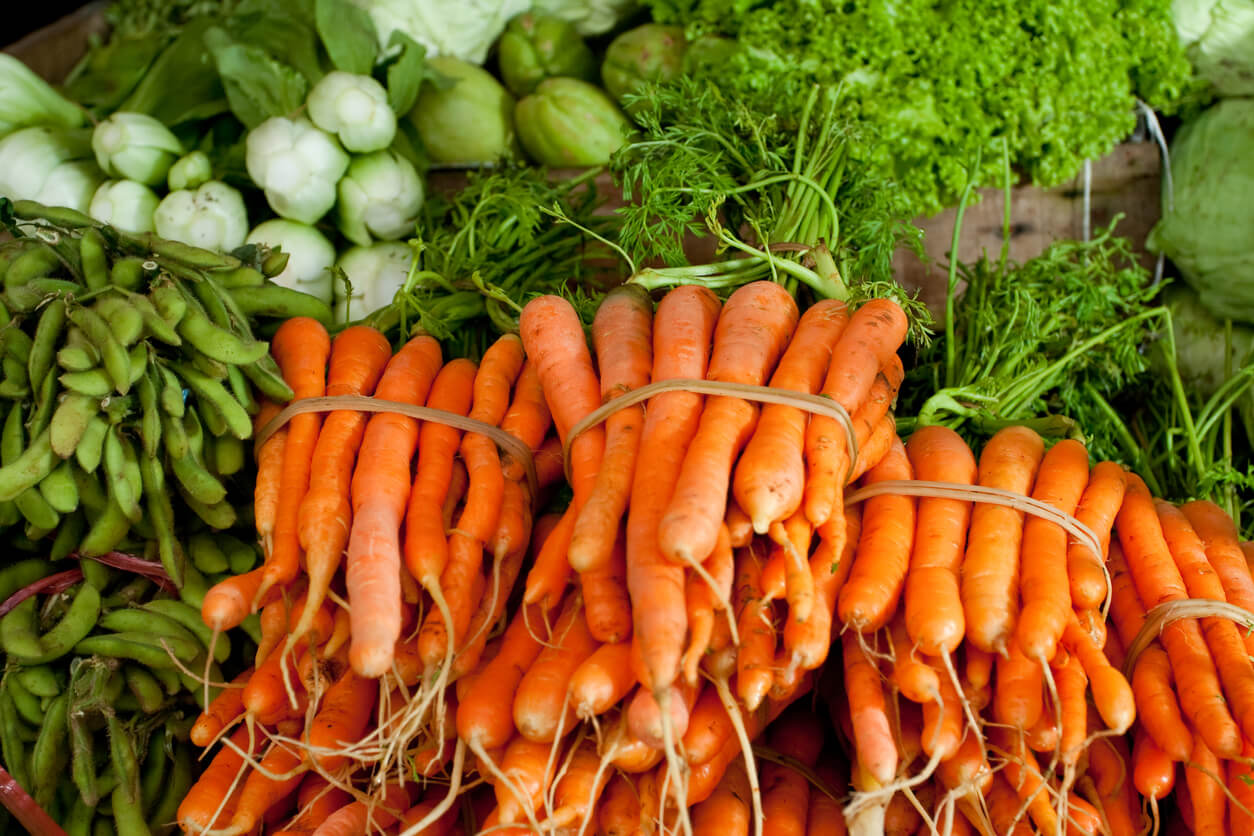
If it’s not obvious by our logo, we love carrots here at Food Revolution Network almost as much as Bugs does. And no wonder: carrots are one of the most popular vegetables, incorporated in countless dishes, eaten on their own as a snack, and pretty easy to find in most places.
And thanks to their associations with classic kids’ cartoons and having better night vision (a myth, by the way — see below for its origin), carrots quickly come to mind during rapid word association when the category “vegetable” comes up. According to the BBC, nine out of ten times when someone plays that game and has to name a vegetable, they’ll say “carrot.” Give it a try, and let us know.
Of course, the bunny association works both ways — some people dismiss carrots as “rabbit food,” along with just about anything else that can go in a salad. But despite the naysayers, Bugs Bunny has the right idea. After all, it’s no surprise that carrots are good for humans, too. But are there any downsides to growing or eating them? And what are some of the best ways to prepare them?
Carrot Origins
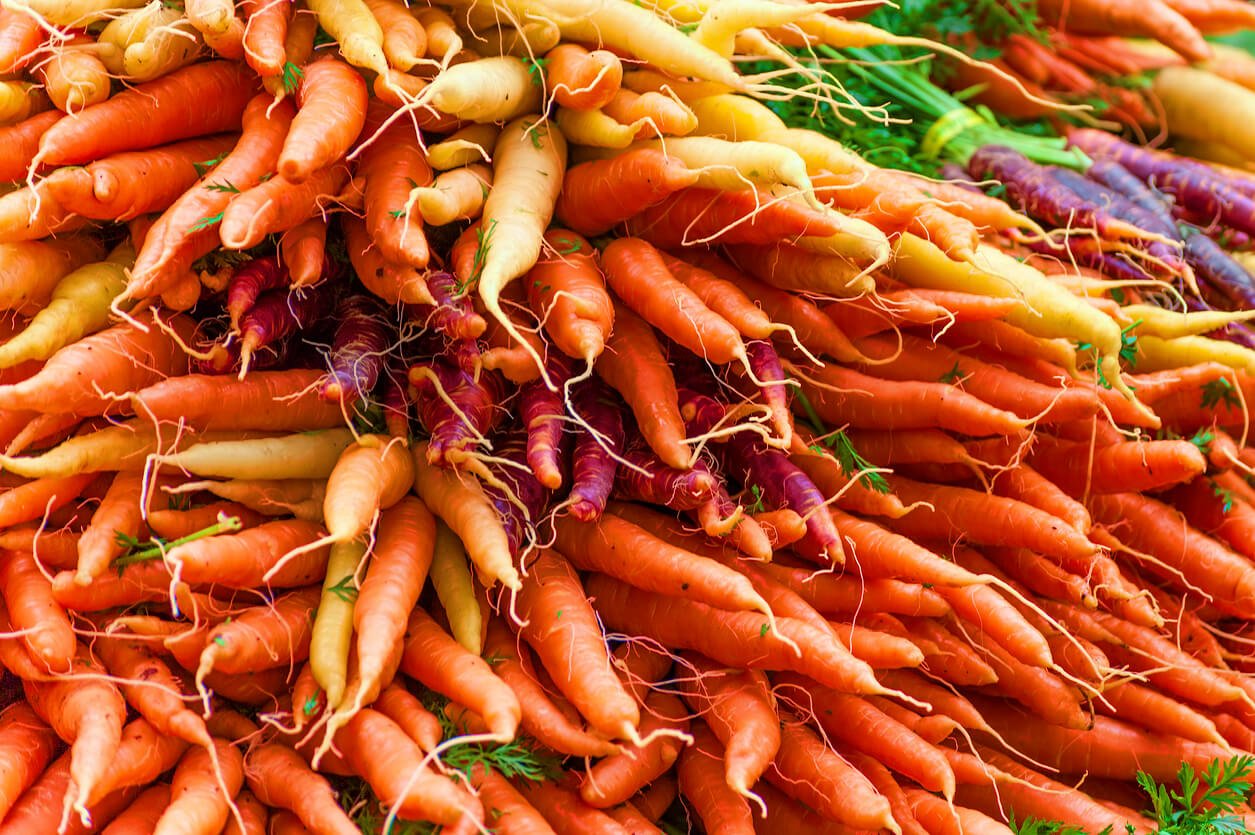
The wild carrot is indigenous to Europe, North Africa, and Western Asia, with the most varieties springing up in modern-day Iran and Afghanistan. Historians have found evidence of human use of carrot seeds as far back as 4,000-5,000 years ago. Our ancestors may have utilized the seeds as medicine, and also perhaps as a cooking spice.
In Egypt, Rome, and Greece, healers prescribed carrots as a healing remedy for numerous illnesses. They also had uses as an aphrodisiac, which may explain the enthusiastic carrot-themed artwork on Egyptian hieroglyphics, and the presence of preserved carrots in Pharaohs’ tombs. Back then, carrots were bitter, difficult to eat on their own, and impossible to consume raw, as they were tough and fibrous.
The first evidence of carrot crops being grown specifically for food was in the Iranian Plateau and Persia during the 10th century. After that, they spread to Andalusia — modern-day Spain — and then to the rest of Europe. During this time, carrots were mainly purple, white, or yellow — a variety reminiscent of those rainbow packages of baby carrots you can find today in some grocery stores.
Orange carrots were bred into existence sometime in the 17th century in Europe and the Mediterranean. At the time, orange was actually a recessive color, possibly created from domesticated yellow carrots. There doesn’t seem to be a biological advantage to an orange hue for the carrot, except that that’s what people seemed to like once they showed up.
It wasn’t until after World War I that carrots became a major player in American cuisine. Thanks to soldiers returning home with seeds, and more importantly, descriptions of delicious European dishes that featured them, people began demanding carrots for both savory and sweet meals.
Types of Carrots
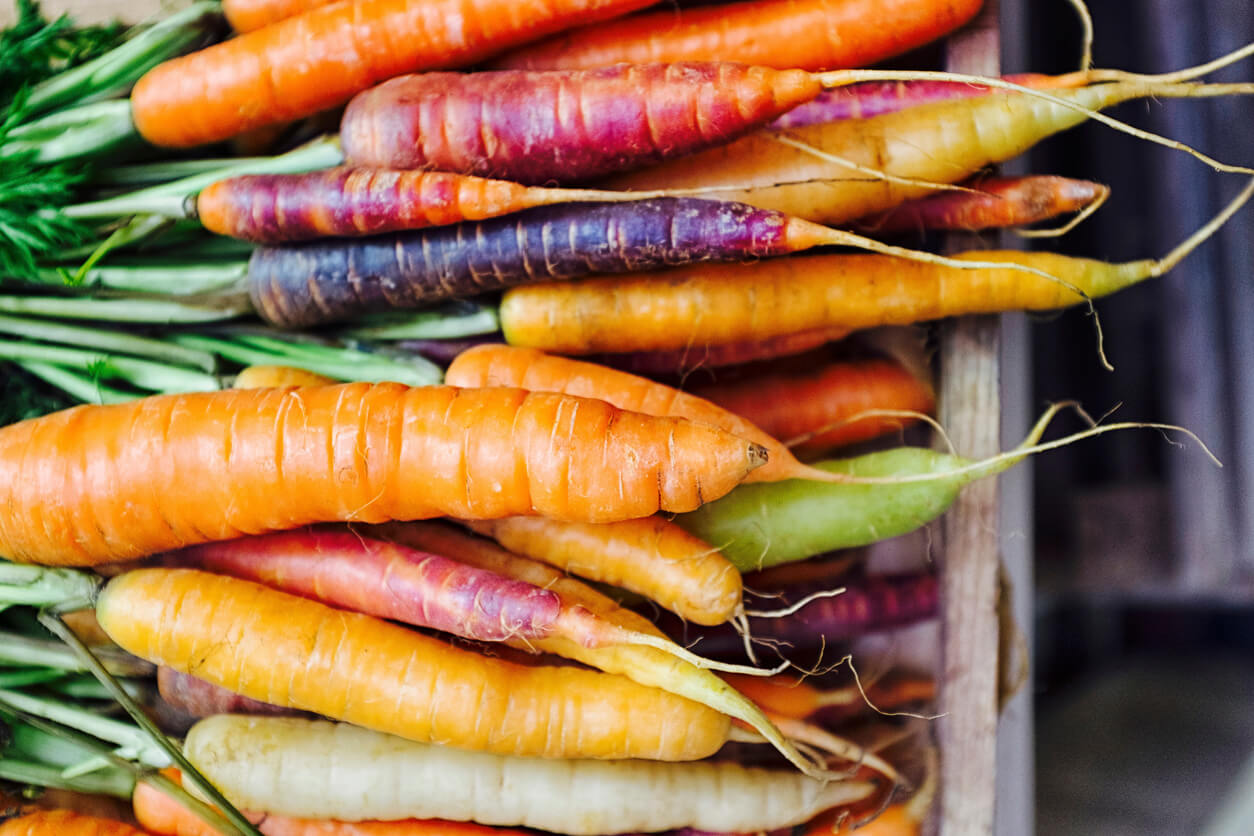
Today, you can bring home a slew of colorful carrots — like purple, black, yellow, white, and red — but orange is still the most common.
Domesticated carrots fall into two main categories. The first is the Eastern or Asiatic carrot, grown around the Himalayas. These types of carrots are rich in anthocyanins, pigmented antioxidants that make them primarily purple, yellow, or black. The second is the Western carrot, which grew largely in the Middle East and Turkey. These carrots are rich in carotenoids, which give them their orange, yellow, red, or white coloring.
There are five main types of Western carrots, which are defined by their shape and size:
- Danvers: These are long and skinny and are your basic poster child for the carrot. Preferred varieties are Yellowstone and Half Long carrots.
- Nantes: These carrots are round at the tip and cylindrical on the top. They also tend to grow quickly. Some common varieties include Napoli, Touchon, Napa, and White Satin carrots.
- Imperator: These are similar to Danver carrots, but are sweeter and thicker. Popular varieties include the Japanese Imperial Long, Cosmic Red, and Sugarsnax 54.
- Chantenay: These carrots are hardier than the rest and can grow in rocky soil or containers at home. They generally grow up to seven inches in length and include varieties like the Red-Cored Chantenay, Hercules, and Carson Hybrid.
- Ball or Mini: These carrots are short and stout, but their resemblance to a little teapot ends there. They tend to be around three to four inches in length and actually look more like radishes than carrots. Sometimes these are cooked and served with their greens still attached. Common varieties include the Babette, Romeo, and Paris Market carrots.
Carrot Nutrition
Carrots are known for their high beta-carotene content. This carotenoid gives the most common orange and yellow varieties their color. Your body naturally converts beta-carotene to vitamin A, an important nutrient for things like eyesight and immunity. And carrots are an excellent source of beta-carotene; one large carrot (say, seven to eight inches long) can provide over two-thirds of your daily requirement of the nutrient.
No matter what color of carrots you enjoy, you’re going to get a good dose of antioxidants. For instance, yellow carrots contain lutein, red carrots contain lycopene, purple carrots contain anthocyanins, and black carrots contain phenolic compounds.
Carrots are also low in calories and fat and high in complex carbohydrates and fiber. And they’re a good source of other micronutrients, like potassium, B vitamins, vitamin C, and vitamin K1.
Carrot Health Benefits

Carrots have been studied for a number of specific health benefits. And the results are impressive.
1. May support eye health.
Many of us have heard we should eat more carrots to see better at night. And while they’re not a miracle food for achieving superhuman night vision, carrots do certainly help support your eyesight.
The myth that carrots contribute to night vision had its origins in British PSYOPs (psychological operations) against their German foes in World War II. Rather than disclose the new onboard radar systems in their planes, which gave the Royal Air Force a huge advantage during night battles, the government launched advertising campaigns telling its citizens that eating carrots would give them excellent night vision, useful during the blackouts in London and other cities. Be like our airmen, the government hinted, and eat your carrots.
Back to known facts. Carrots are rich in antioxidants, like beta-carotene, lutein, and zeaxanthin, which are known to help protect your eyes. They’ve even been included in studieds on age-related macular degeneration (AMD) as well as preventing and reducing cataracts.
2. May have anticancer benefits.
The bioactive compounds in carrots may also protect against the development and progression of certain types of cancer. A 2014 review found that eating carrots is associated with a significantly decreased risk of prostate cancer. The relationship appeared to be linear; for every additional 10 gram serving of carrots that men ate per day (equivalent to about one whole carrot), there was an approximately 5% reduction in prostate cancer risk.
In an older 1986 study, researchers interviewed 417 people with lung cancer and 849 people in a control group on their life-long tobacco usage and current intake of foods rich in retinol or carotene. They found that current smokers who did not eat carrots had triple the odds of getting lung cancer compared to those who ate carrots more than once a week (though not smoking and eating plenty of carrots seems to be the best choice).
In a 2018 meta-analysis including 10 studies and 13,747 breast cancer cases, researchers found that eating carrots may be associated with a lower risk for breast cancer. And the authors of a 2015 meta-analysis found that eating carrots was also associated with a lower risk for stomach cancer.
3. May help support immune defense.
Whole plant foods are natural immune-boosters, and carrots are a prime example. Beta-carotene and other carotenoids found in carrots help support the normal function of your immune system, which helps protect you against a number of illnesses and infections. Carrots are also rich in vitamin C, a natural antioxidant and major player in immunity.
While people can be allergic to them, some research suggests that when pregnant women eat carrots, it may help prevent allergic diseases from developing in their children. And the high beta-carotene content in carrots may also help control asthma symptoms in adults.
4. May support heart health.
Epidemiological studies have suggested that eating a diet rich in carrots may be helpful in improving heart health. For instance, in a 2008 study, the intake of beta-carotene was found to be inversely associated with the risk of death from cardiovascular disease over a 15-year period in elderly men.
And in a 2021 animal study published in Nutrients, researchers found that carrots helped correct various metabolic and cardiovascular disorders in mice with a genetic predisposition to atherosclerosis. (Our view on the use of animals in medical research is here.)
Other animal research suggests that one way carrots may help protect the heart is by modifying the way cholesterol is absorbed, and bile acids get excreted. It may also boost the availability of antioxidants, all of which may help reduce heart disease risk.
5. May benefit blood sugar control.
Carrots may be beneficial for people with diabetes, likely thanks to their carotenoid content.
For instance, a 2018 animal study published in Preventive Nutrition and Food Science found that when rats with type 1 diabetes received a supplement with carrot powder for three weeks, their blood sugar levels were significantly reduced, compared to diabetic rats who did not receive the powder.
And in a 2015 study, researchers examined data from 37,846 participants of the European Prospective Investigation into Cancer and Nutrition-Netherlands study. They found that diets high in carotenoids, particularly beta-carotene and alpha-carotene, were associated with a lower risk for type 2 diabetes.
Eating carrots may also be helpful with potential diabetes-related complications, such as diabetic retinopathy (DR), a condition in which neurons in the retina begin to degrade and can lead to severely impaired vision or even blindness. A 2019 study found that treating people at early stages of DR with antioxidant and carotenoid-rich foods, like carrots, may be helpful in slowing its progression.
Carrot Concerns
Carrots offer plenty of health benefits, but can you eat too many of them? Well, like pretty much anything else, you can still get too much of a good thing with carrots. Carrots, green leafy vegetables, and sweet potatoes contain provitamin A — in the form of beta-carotene and other carotenoids — that your body turns into vitamin A. It’s possible to overconsume carrots to the point of vitamin A toxicity.
Vitamin A Toxicity
The risk of vitamin A poisoning due to eating too many carrots, however, is far less likely than if you were to take vitamin A in the form of a supplement.
Still, there are reports of excessive carrots becoming problematic. For instance, there’s a documented case of a man who consumed around six to seven pounds of carrots per week — basically one pound per day — who presented with elevated liver enzymes, constipation, and “possible vitamin A toxicity.” One of the man’s most prominent features was the visible change in his skin color, which was turning yellowish-orange, also known as hypercarotenemia or too much carotene in the body.
Fortunately, vitamin A toxicity generally has a good prognosis. You can usually make a complete recovery if the excessive ingestion of vitamin A stops. Signs and symptoms of chronic vitamin A toxicity disappear within a few weeks upon addressing the underlying source.
Even if you’re a super-fan of carrots, you’re probably not at great risk for this issue unless your consumption is similar to the guy from the case report. To give you some context, one pound of carrots is around six full-sized carrots. This amount contains approximately double the recommended dietary intake (RDI). To play it safest, you may want to limit your carrot intake to an average of no more than three full-sized carrots per day to stay under the RDI, assuming you’re getting some vitamin A from other sources as well.
Carrot Allergy

Another potential concern is that some people are allergic to carrots. Allergic reactions to carrots affect up to 25% of people with food allergies. While we don’t hear about carrot allergies very often, they’re in the birch pollen family of allergies and part of oral allergy syndrome, a type of contact allergen reaction that occurs in the mouth or throat when people consume certain fruits and vegetables.
There’s also some evidence that people who are allergic to raw carrots aren’t necessarily allergic to cooked ones. A study published in The Journal of Allergy and Clinical Immunology found that the potentially allergenic proteins in carrots unravel when cooked, which prevents them from triggering the same degree of immune response as when eaten raw.
Researchers think this is because the denatured proteins can’t bind to and be recognized by antibodies, so there’s no strong immune response. However, while some people with a carrot allergy didn’t have severe symptoms from cooked carrots — like swelling and breathing problems — they did still get a secondary rash response. Because there’s still some reaction, the authors recommended that people with carrot allergies continue to avoid both raw and cooked versions to be safe.
Are Carrots Sustainable?

We’ve examined carrots in-depth as far as health goes, but what about their impact on the environment? There are two sides to every coin, so let’s start with the good news.
Interestingly, carrots are a sustainable building material. In fact, researchers have figured out how to blend carrots and mix them with small amounts of concrete, which may actually help increase the strength of concrete by 80%! Why? Their strengthening ability may come from the cellulose, or plant fiber, in carrots. Could carrots be a key to future green building? I’m intrigued.
Now for the less-than-amazing news. Carrots earn a low to moderate pesticide residue score according to the Environmental Working Group (EWG). This means that while carrots aren’t in the “Dirty Dozen,” they don’t crack the “Clean 15” either. The USDA notes 26 potential pesticides are used on carrot crops, some of which may be carcinogens, hormone disruptors, neurotoxins, and reproductive toxins, as well as threatening to honeybees.
To be safe, it’s best to buy organic carrots if possible. Carrots can absorb pesticide residues from soils. And because the edible part is a root, they are fully immersed in the soil around them.
As for GMOs, there was talk of developing GMO carrots around 2008 that would theoretically provide extra calcium to help prevent diseases like osteoporosis. But as of 2021, this has not been approved. Carrots are not among the current GMO crops in the US.
Many carrots are also grown in California, a state with persistent drought problems. Fortunately, compared to other vegetables, carrots consume a relatively moderate amount of water. To support your local economy, invest in local farms, and enjoy the freshest and most sustainable carrots, try to buy them locally-grown when you can. Carrots are commonly available at farmers markets, through community-supported agriculture (CSA) programs, or U-pick farms. Or, you might fancy growing your own.
Growing Carrots
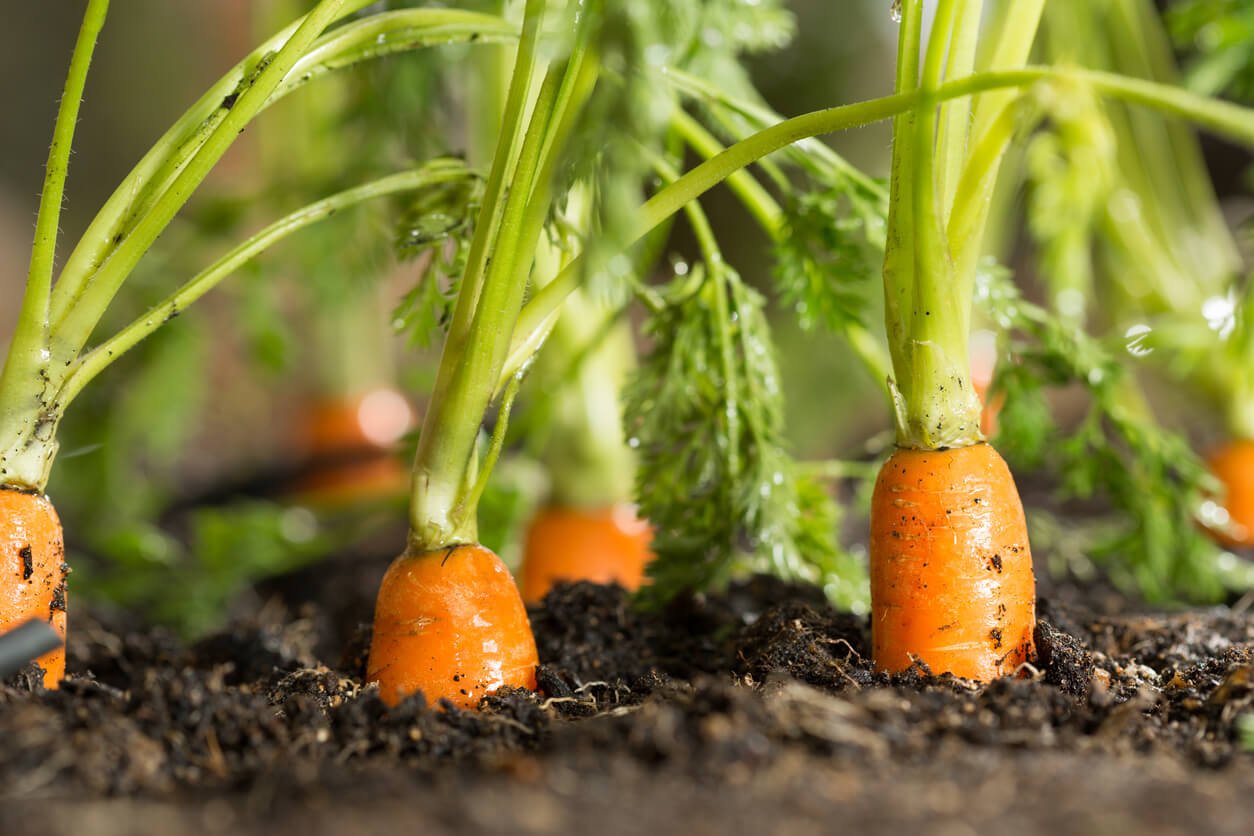
Carrots need some special consideration in your garden since they’re root vegetables, and you can’t disturb their roots while growing. They need deep, loose soil and a consistent water source for the best results. The good news is that they’re pretty hardy and can be grown in most zones (specifically, zones 3-10 tend to do well with carrots).
If you want to grow long carrots, but don’t have a deep enough layer of topsoil to allow them to grow down unimpeded, consider building raised beds. That way, instead of needing multiple cubic yards of soil, compost, and other organic matter over your entire garden, you can put much smaller amounts to use just where you need a foot or more of topsoil.
Plant carrots during the cooler periods of the growing season — spring and fall — as they can tolerate frost well. Though the seeds will germinate in soil as cold as 50 degrees, they prefer a 70-degree environment. Ideally, plant carrots in areas that receive full sun most of the time. It may take a few weeks for carrot seeds to germinate, and they’re typically ready for harvesting after approximately 50-75 days.
How to Choose & Store Carrots

When choosing carrots, look for ones that are firm, smooth, and brightly colored. The deeper the orange color, the more beta-carotene they contain (the same goes for other colors and their respective antioxidants). Avoid carrots with excessive cracks, as well as those that are limp or rubbery. In addition, if the carrots don’t have their green tops, look at the stem ends to be sure they’re not darkly colored, as this is also a sign of age. After all, you want your carrots to last!
With proper storage methods, carrots can last in the refrigerator for up to a month. Cut off carrot greens if you purchase them intact. Then, for maximal longevity, place the carrots in an airtight container (like these ones), cover them in water, and store them in the fridge. Be sure to replace the water every five days to keep the carrots fresh. Avoid direct exposure to sunlight or air, as this can promote degradation.
Additionally, don’t store your carrots next to fruits like apples, bananas, and pears, because they all give off ethylene gas, which speeds up the ripening process of other fruits and veggies, shortening their shelf life. Carrots will deteriorate quickly in the presence of this gas, producing a substance called isocoumarin that makes them bitter.
If you’re not planning to use your carrots for a while, you can also prepare them for longer-term storage. A root cellar or another dark, cool, and well-ventilated area can work well for this. And the carrots may last up to five or six months. They can also be stored unwashed and covered by sand. Or, you can leave homegrown carrots in the ground, covered by mulch. They can stay here and be used at your convenience unless you’re heading into colder months when the ground begins to freeze. Finally, you can even prepare your carrots for long-term freezer storage. Just peel, slice, and blanch them before storing them in a freezer-safe container, where they’ll last for up to one year.
How to Cook & Prepare Carrots
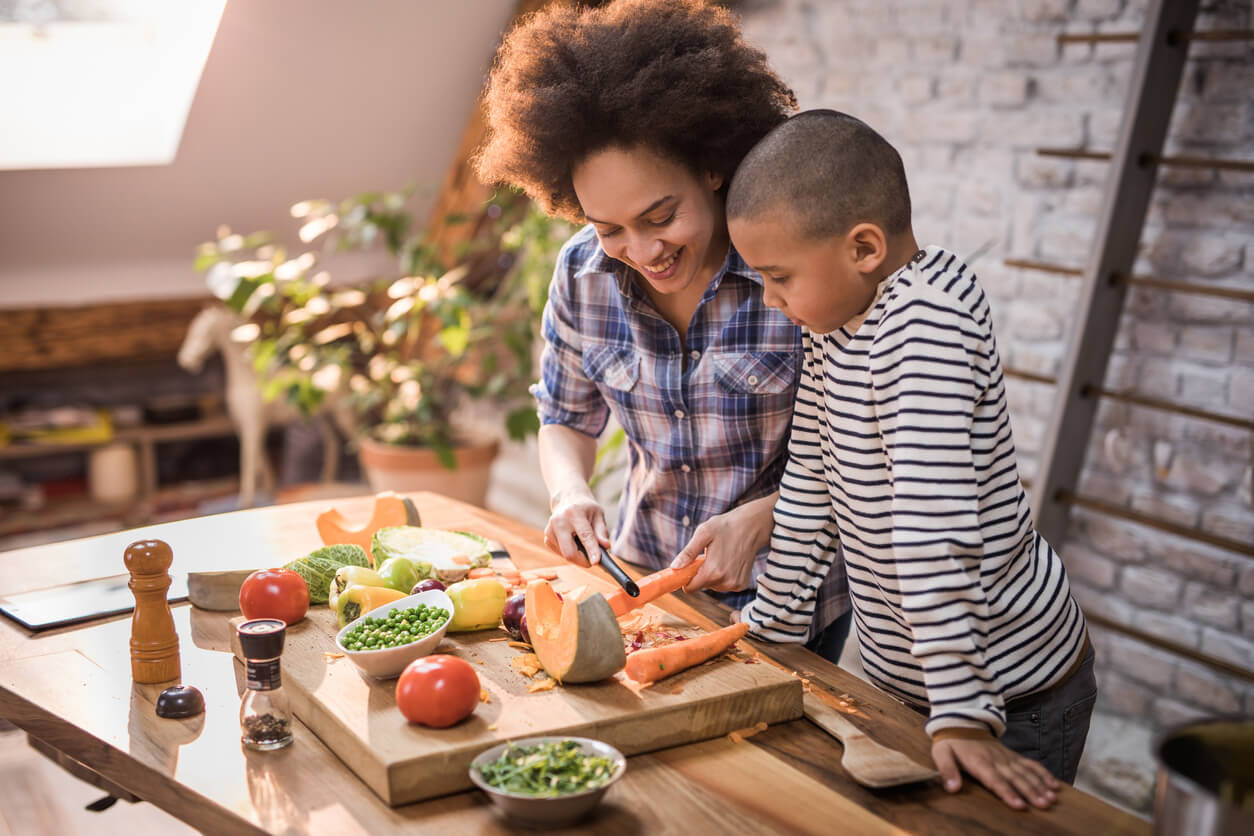
Carrots are incredibly low maintenance. In fact, you don’t even need to peel them before you eat them. It’s best to wash them, though, if you want to remove dirt and pesticide residue from the surface. Whether you peel them really just depends on how you plan to use them. Consider keeping the peel if you’ll be making a soup or stock, or if you’re juicing or roasting them because the peel contains most of the fiber and is a rich source of niacin and vitamin C.
Carrots are tasty, not only raw but also cooked. I love to roast, boil, steam, or even saute them in a pan until they’re warm and tender. You can also eat their tops. As for how cooking carrots affects their properties, one study from 2016 found that microwaving them seems to be the most favorable method for retaining the most nutrients, textures, and colors.
And with carrots, raw isn’t necessarily better. In a 2003 comparative study, significantly more beta-carotene was absorbed from meals containing cooked, pureed carrots than from meals containing the raw vegetable.
Either way, you can’t really go wrong with carrots. To get the most benefit, and the most versatility, consider rotating various methods of preparing them, including leaving them raw.
Ways to Use Carrots
Here are some great ways to use carrots:
- Cooked in soups and stocks
- In salads and coleslaws
- Pureed into dressings, dips, and sauces
- Juiced and in smoothies
- In stir-fries and power bowls
- Desserts
- In sweet or savory breakfasts
- Roasted in the oven with other vegetables
- Rolled up in veggie sushi rolls
- Made into carrot bacon
For more specific ideas, try some of the recipes below!
Carrot Recipes
Carrots aren’t just for crunchy snacking (although they do make a pretty darn good nosh!). Start your day with Carrot Cake Overnight Oats, an energizing breakfast that takes only minutes to prepare. Create pourable carrots with the Carrot Ginger Dressing that’s ready to top everything from salads to grain bowls to steamed veggies. Or enjoy your carrots warm and puréed by making the Sweet Potato Carrot Soup with Toasted Sunflower Seeds. We hope you appreciate the carrot’s versatility as much as we enjoyed creating these carrot-centric recipes for you!
1. Carrot Cake Overnight Oats
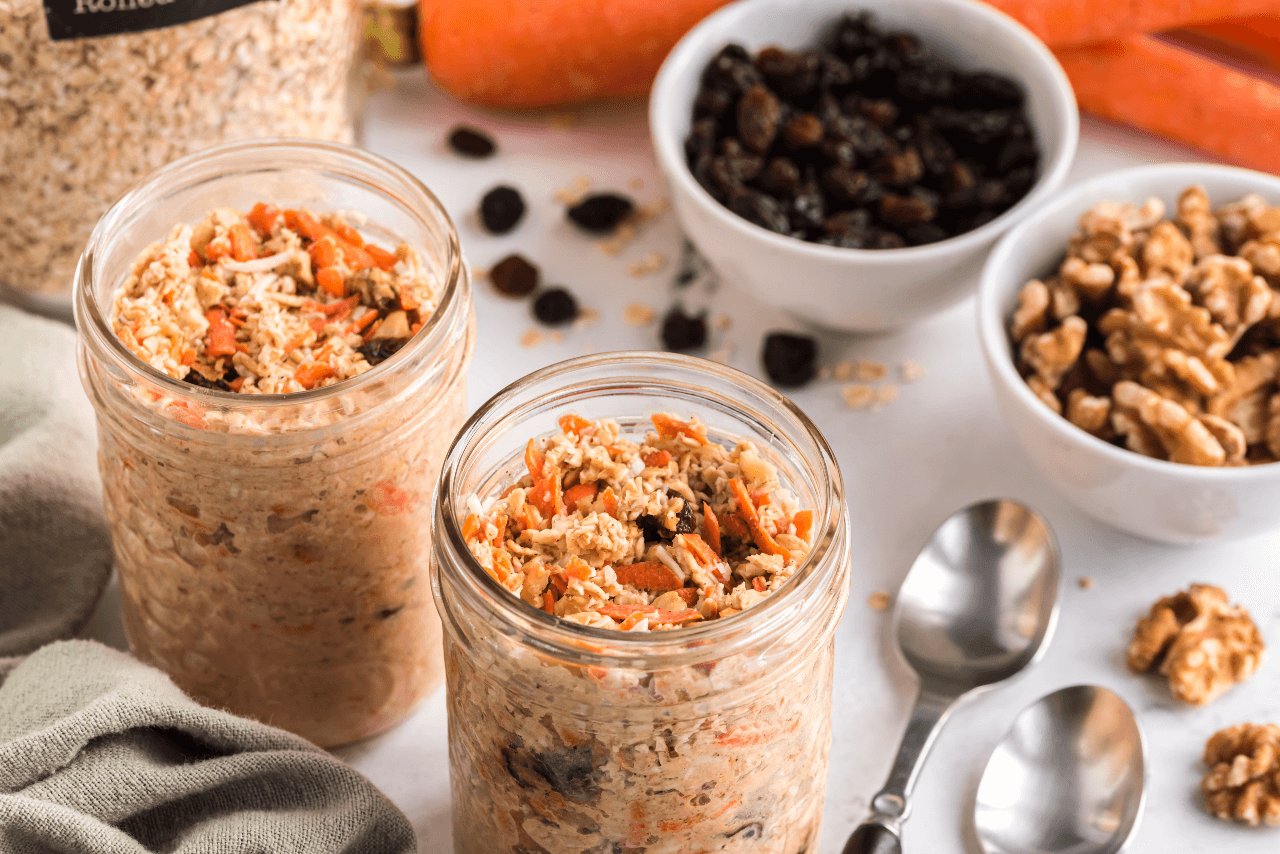
Carrots for breakfast? You bet! Starting your day with nutrient-rich veggies can help you begin a fabulous day! This overnight oatmeal captures all the best flavors of carrot cake without unwanted ingredients. It’s high in fiber, vitamins, and minerals that will help to power you through the morning and beyond. The next best thing to this breakfast’s nutrition is the time it takes to make it, which is less than five minutes!
2. Carrot Ginger Dressing
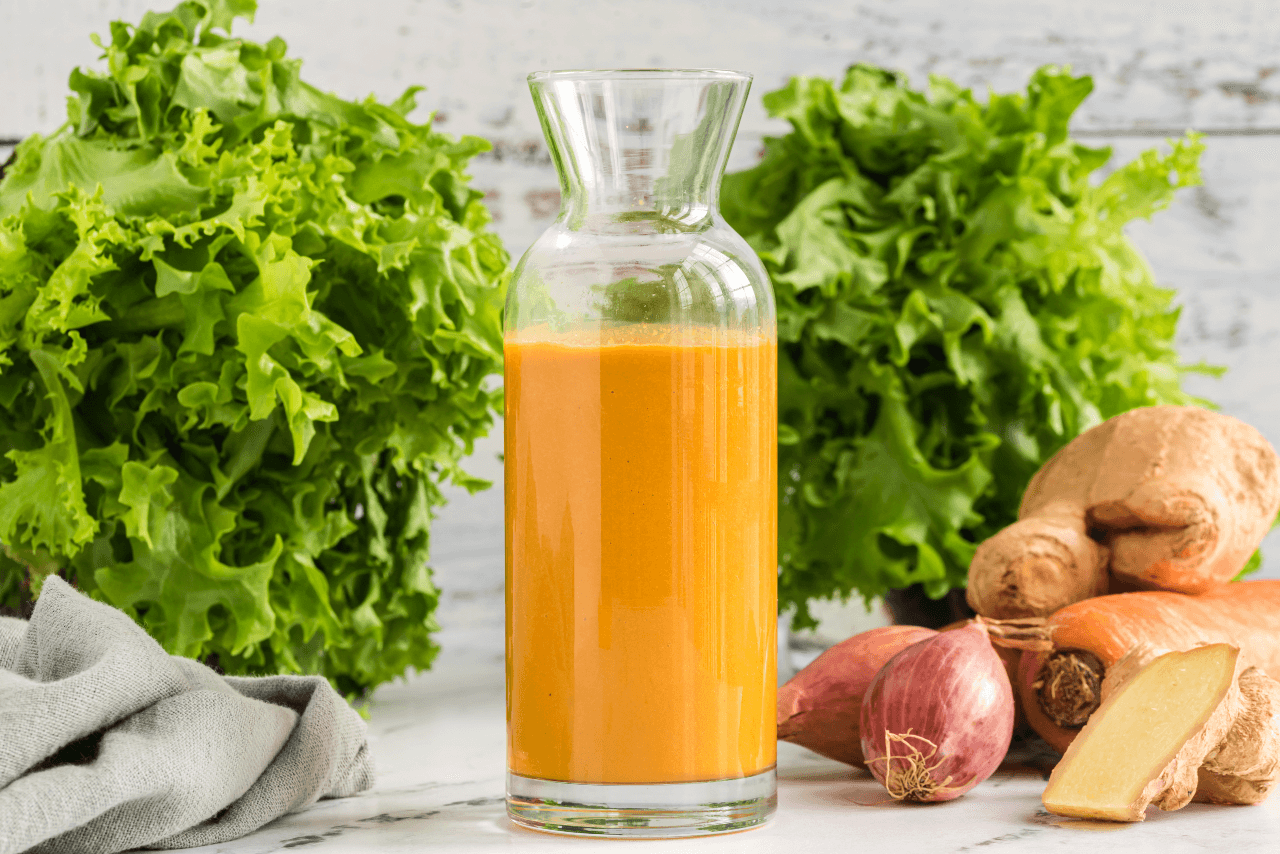
If you’re familiar with the light and refreshing orange-hued ginger dressing that tops many-a-bowl of lettuce in a Japanese restaurant, then you’ll recognize the flavors and textures here. Carrots give this dressing its pretty orange color and fun texture, while ginger adds some zest and spice. Enjoy it as a salad dressing, in grain bowls, or on top of steamed veggies.
3. Sweet Potato Carrot Soup with Toasted Sunflower Seeds
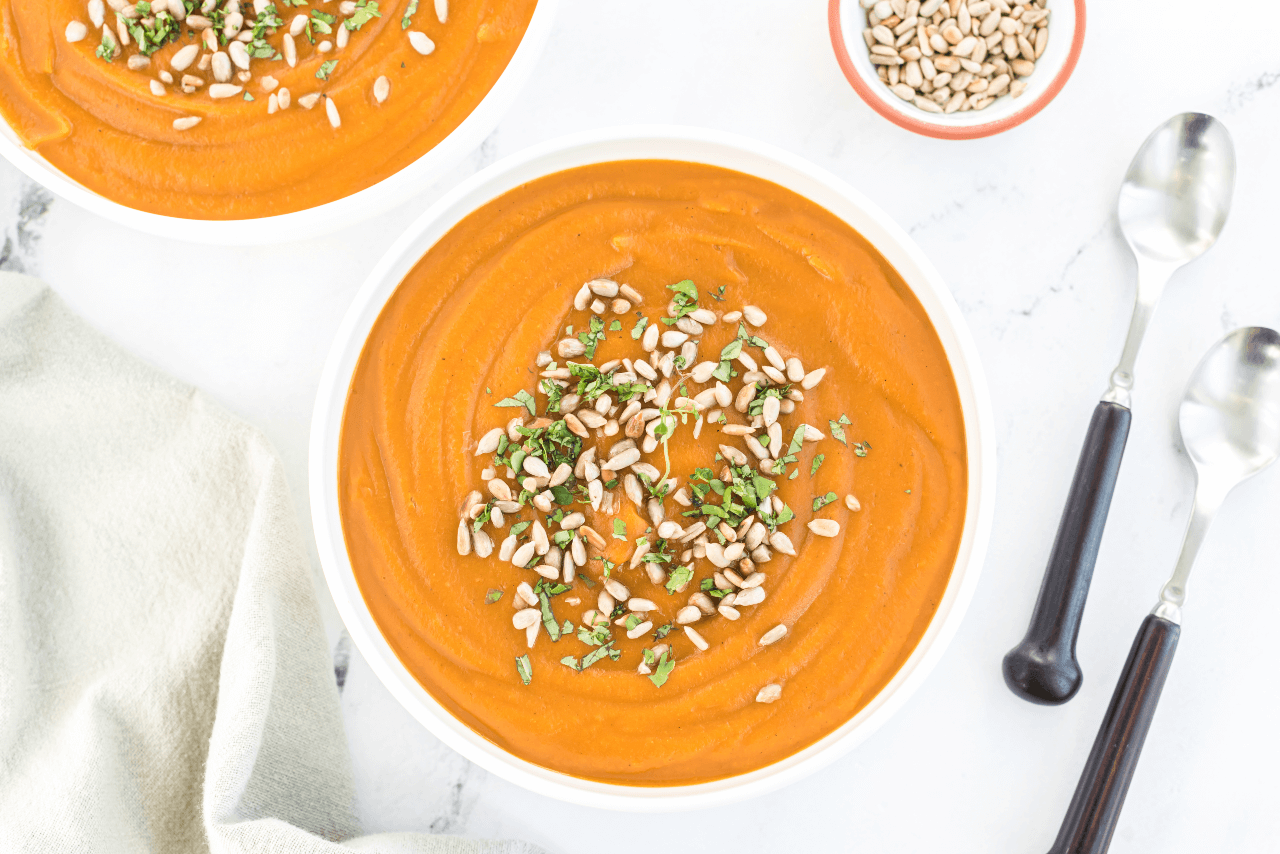
Creamy and comforting, this delicious soup uses nutrient-rich carrots and sweet potatoes as its base. These root veggies get their vibrant orange colors from carotenoids, compounds that act as antioxidants in the body, scavenging free radicals and protecting it from lifestyle diseases. They’re also both packed with fiber, making this soup gut-loving and satisfying.
Carrots Are Not Just Rabbit Food
Carrots have a long history of usage, first as a spice and medicine, and then as a cultivated food. They have a number of health benefits due to their high levels of antioxidants like beta-carotene. But eating too many carrots could potentially contribute to vitamin A toxicity. Luckily, this is incredibly rare unless you’re eating many pounds per week.
Carrots are also a relatively sustainable crop from an environmental perspective. And this crunchy, delicious veggie can last for a long time in your kitchen, whether you use it in sweet or savory recipes.
Although carrots are Bugs Bunny approved, as you can see, they are a lot more than just rabbit food.
Tell us in the comments:
- How many carrots do you eat each week?
- What are some of your favorite ways to enjoy raw and cooked carrots?
- Have you tried other colors of carrots besides orange?
Featured Image: iStock.com/PhotoAttractive

